Analyzing the Factors Influencing the Satisfaction of Students Who Use English as a Second Language (ESL), at a Language Training Center in UAE
DOI:
https://doi.org/10.60072/ijeissah.2025.v3i02.001Abstract
This study explores the key factors influencing the happiness and satisfaction of ESL (English as a Second Language) students at a prestigious Language Training Centre in the United Arab Emirates. As English proficiency becomes increasingly essential in a globalised world, non-native speakers often turn to language training institutions for improvement. To remain competitive, these centres must ensure high student satisfaction. Previous research highlights various factors affecting satisfaction, including course content, teaching quality, learning environment, and student support. Building on these findings, the present study surveyed 125 ESL students to identify the most influential variables affecting their satisfaction. Four key factors were selected: customer relationship management, support facilities, academic staff quality, and promotional effectiveness. Using SPSS for data analysis and applying regression analysis, the study assessed the impact of these variables on overall student satisfaction. The results confirmed that all four factors significantly influence ESL students’ satisfaction. These insights offer valuable guidance for language centres aiming to enhance their service quality and better meet student expectations.
Keywords:
ESL, Customer Relationship, Students’ Satisfaction, SURVQUAL, Strategic MarketingReferences
Adnan, A. R., Mohamed, A. F., Tarek, A., Mun, S., & Hosny, H. (2016). Measuring student satisfaction with performance enhancement activities: Evidence from business education. International Journal of Information and Education Technology, 6(10), 741-753. DOI: https://10.7763/IJIET.2016.V6.786
Al Hammadi, A. H. Y. (2021). The role of national culture on the relationship between leadership styles and job satisfaction among public universities in the United Arab Emirates (Doctoral dissertation, Universiti Tun Hussein Onn Malaysia). http://eprints.uthm.edu.my/id/eprint/1774
Appleton-Knapp, S. L., & Krentler, K. A. (2006). Measuring student expectations and their effects on satisfaction: The importance of managing student expectations. Journal of marketing education, 28(3), 254-264. DOI: https://doi.org/10.1177/0273475306293359
Bergeson, T., & Heuschel, M. A. (2005). Promising programs and practices for dropout prevention: Report to the legislature. Office of Superintendent of Public Instruction, Olympia, WA, http://www. kl2. wa. us/research/default. aspx (86 pages).
Brown, H. D., & Lee, H. (2025). Principles of language learning and teaching: A course in second language acquisition. Taylor & Francis.
Chiu, Y. J. (2009). Exploring pedagogical strategies to integrate a holistic approach to education into ESL classes. Asia Pacific Education Review, 10(2), 261-270.
Coelho, D., & Steinhagen, T. G. PLURILINGUAL PEDAGOGY IN THE ARABIAN PENINSULA.
Douglas, J., Douglas, A., & Barnes, B. (2006). Measuring student satisfaction at a UK university. Quality assurance in education, 14(3), 251-267. https://doi.org/10.1108/09684880610678568
Echiverri, L. L., & Lane, K. (2019). Influence of learning attitudes and task-based interactive approach on student satisfaction and perceived learning outcomes in a content and language integrated learning (CLIL) university course in China. In Teachers’ Professional Development in Global Contexts (pp. 140-159). Brill. DOI: https://doi.org/10.1163/9789004405363_008
Elliott, K. M., & Healy, M. A. (2001). Key factors influencing student satisfaction related to recruitment and retention. Journal of marketing for higher education, 10(4), 1-11. DOI: https://doi.org/10.1300/J050v10n04_01
Gardner, R. C. (1985). Social psychology and second language learning: The role of attitudes and motivation. (No Title).
Kärnä, S., & Julin, P. (2015). A framework for measuring student and staff satisfaction with university campus facilities. Quality Assurance in Education, 23(1), 47-66. DOI: https://doi.org/10.1108/QAE-10-2013-0041
Khan, M. M., Ahmed, I., & Nawaz, M. M. (2011). Student's perspective of service quality in higher learning institutions; An evidence based approach. International Journal of Business and Social Science, 2(11).
Krejcie, R. V., & Morgan, D. W. (1970). Determining sample size for research activities. Educational and psychological measurement, 30(3), 607-610. DOI: https://doi.org/10.1177/001316447003000308
Lynam, T., Damayanti, R., Rialine Titaley, C., Suharno, N., Bradley, M., & Krentel, A. (2020). Reframing integration for mixed methods research. Journal of Mixed Methods Research, 14(3), 336-357. https://doi.org/10.1177/1558689819879352
Martirosyan, N. (2015). An examination of factors contributing to student satisfaction in Armenian higher education. International Journal of Educational Management, 29(2), 177-191. DOI: https://doi.org/10.1108/IJEM-09-2013-0143
Nasser, R. N., Khoury, B., & Abouchedid, K. (2008). University students' knowledge of services and programs in relation to satisfaction: a case study of a private university in Lebanon. Quality Assurance in Education, 16(1), 80-97. https://doi.org/10.1108/09684880810848422
Nunan, D. (2003). Practical english language teaching. https://ebooksz.net/2015/08/27/download-practical-english-language-teaching-pdf/
Nunnally, J., & Bernstein, I. (1994). Psychometric Theory 3rd edition (MacGraw-Hill, New York).
Saunders, M., Lewis, P., & Thornhill, A. (2009). Research methods for business students. Pearson education.
Silverman, R. M., & Patterson, K. (2021). Qualitative research methods for community development. Routledge. https://doi.org/10.4324/9781003172925
Singleton, D. (2014). How useful is second language acquisition research for language teaching?. Key topics in second language acquisition, 109-24. https://doi.org/10.21832/9781783091812-009
Trent, J. (2013). From learner to teacher: Practice, language, and identity in a teaching practicum. Asia-Pacific Journal of Teacher Education, 41(4), 426-440. https://doi.org/10.1080/1359866X.2013.838621
























